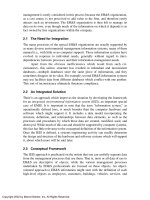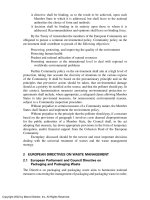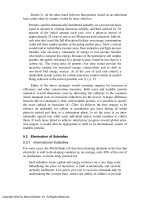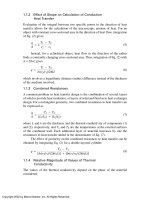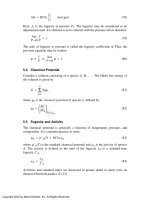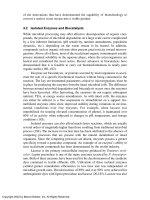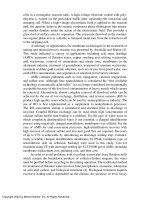Process Engineering for Pollution Control and Waste Minimization_5 potx
Bạn đang xem bản rút gọn của tài liệu. Xem và tải ngay bản đầy đủ của tài liệu tại đây (843.72 KB, 26 trang )
1.1.2 Effect of Shape on Calculation of Conduction
Heat Transfer
Evaluation of the integral between two specific points in the direction of heat
transfer allows for the calculation of the macroscopic amount of heat. For an
object with constant cross-sectional area in the direction of heat flow, integration
of Eq. (2) gives:
q
A
= k
T
1
− T
2
s
2
− s
1
(5)
Instead, for a cylindrical object, heat flow in the direction of the radius
finds a constantly changing cross-sectional area. Thus, integration of Eq. (2) with
A = 2πrL gives
q =
T
1
− T
2
ln(r
2
/r
1
)/2πkl
(6)
which involves a logarithmic distance (radius) difference instead of the thickness
of the medium involved.
1.1.3 Combined Resistances
A common problem in heat transfer design is the combination of several layers
of solid to provide heat insulation, or layers of solid and fluid as in heat exchanger
design. For a rectangular geometry, two combined resistances to heat transfer can
be expressed as
q
A
=
T
1
− T
2
(L
1
/k
1
)+(L
2
/k
2
)
(7)
where L and k are the thickness and the thermal conductivity of components (1)
and (2), respectively, and T
1
and T
2
are the temperatures at the external surfaces
of the combined wall. Each additional layer of material increases by one the
resistances to heat transfer added in the denominator of Eq. (7).
The effect of geometry on the combined resistances to heat transfer can be
obtained by integrating Eq. (2) for a double-layered cylinder:
q =
T
2
− T
1
[ln(r
2
/r
1
)/(2πk
1
L)] + [ln(r
3
/r
2)
/(2πk
2
L)]
(8)
1.1.4 Relative Magnitude of Values of Thermal
Conductivity
The values of the thermal conductivity depend on the phase of the material
considered:
Copyright 2002 by Marcel Dekker, Inc. All Rights Reserved.
k
gas
< k
liquid
< k
solid
Thus, solid materials are good heat conductors, while for heat insulation trapped
gases are the best option. Good electric conductor metals are the best selection
for heat conductors. The design of heat insulation follows the criteria for air
entrapment in fabrics or ceramics that could be resistant to high temperatures.
1.2 Convection
Heat convection is described as heat transport in fluid eddies promoted by the
flow derived from a mechanical device, a pump or fan (forced convection), or a
density difference (natural convection). The mechanism is associated with the
definition of the convective heat transfer coefficient, h(W/m
2
˚C):
h =
q
A(T
2
− T
1)
(9)
As the turbulent flow process carrying the heat cannot be fully described,
the temperature difference is considered at two points (1) and (2) in the direction
of heat transfer. It is not possible to describe this process through a differential
equation, and Eq. (9) is a definition for h that is related to the specific geometry
associated to the surface area, A, and the flow conditions.
The convective heat transfer coefficient can be calculated for design
purposes from experimental information gathered in the open literature. Experi-
ments have been carried out under geometry, flow range, and similar thermo-
physical properties conditions that can be encountered in process applications.
The information has been grouped in terms of flow conditions and thermophysical
properties involved.
Flow conditions are described through the Reynolds number (Re) for forced
convection. The Reynolds number relates the momentum convection associated
to the flow velocity, v, to the momentum diffusivity associated to ν, the kinematic
viscosity (ν = µ/ρ), µ is Newtonian viscosity (kg/ms). At low Reynolds numbers,
implying low flow velocity, momentum diffusivity dominates, and the fluid
displacement is in the laminar flow condition. When the flow velocity is high
relative to the kinematic viscosity, the Reynolds number is high, indicating
turbulent flow conditions.
Re =
Lν
v
(10)
L is the flow characteristic length; for internal flow in circular pipes, L is the
internal diameter.
The Grashof number (Gr) describes flow conditions for natural convection
and is used instead of the Reynolds number.
Copyright 2002 by Marcel Dekker, Inc. All Rights Reserved.
Gr =
gβ(T
w
− T
infinity
)L
3
v
2
(11)
Here g is the acceleration of gravity, T
w
is the solid wall temperature, T
infinity
is
the fluid bulk temperature, L is the heat transfer characteristic length, and β is the
volume coefficient of expansion:
β=
(ρ
infinity
−ρ)
ρ(T − T
infinity
)
(12)
ρ
infinity
is the fluid bulk density.
In natural and forced convection, the Prandtl number describes the influ-
ence of thermophysical properties in the calculation of the convective heat
transfer coefficient, normally to the
1
⁄
3
power.
Pr =
v
α
=
C
p
µ
k
(13)
The Nusselt number, Nu, is the ratio of heat convection to diffusion
associated to the heat transfer characteristic length, L:
Nu =
hL
k
(14)
From the exact analysis of the boundary layer between the fluid and the
solid wall transferring heat, the correlation in forced convection among Nusselt,
Reynolds, and Prandtl numbers is
Nu = 0.664 Re
1/2
Pr
1/3
(15)
This theoretical correlation has very limited application, and the depend-
ence of these dimensionless numbers on the geometry makes experimentation
necessary to calculate correlations for each geometry. The correlation results are
normally reported with the same mathematical formulation:
Nu = c
0
Re
n
Pr
m
(16)
For natural convection, the analysis of the boundary layer provides the
correlation of the important dimensionless numbers:
Nu = C(Gr Pr)
m
(17)
1.3 Radiation
For practical conditions, radiation emitted (or received) by surface is calculated
from an equation that involves the effect of the area, A
12
, the emissivity, ε
1
, of
the emitting surface involved, and a view factor, F
12
, that describes the effect
Copyright 2002 by Marcel Dekker, Inc. All Rights Reserved.
of the relative positions of the two surfaces involved on the amount of radiation
exchanged. The formulation of the exchanged radiation is
q =σε
1
A
12
F
12
(T
1
4
− T
2
4
) (18)
All practical terms in Eq. (18) are measured experimentally and are reported in
several references (e.g., Ref. 2)
2 HEAT ACCUMULATION
Heat accumulation is described through the heat capacity. The specific property
normally used to achieve this calculation is the constant-pressure heat capacity,
C
p
(J/kg ˚C). The total amount of material that stores heat should be expressed in
the mass or molar terms used for the C
p
. The heat stored is then a function of the
temperature change in the total mass considered:
C
p
=
q
m(dT/dt)
(19)
The temperature variation with time allows the evaluation of the heat flow
accumulated.
2.1 Sensible Heat
The variation of the temperature in a fluid medium defines sensible heat. The
calculation of the amount of sensible heat is obtained from Eq. (19). The heat
capacity should correlate the fluid and phase considered.
2.2 Latent Heat
The process where a change of phase takes place requires the addition of latent
heat. The latent heat is used to change phase in a fluid without a change in the
medium temperature. The evaluation of the latent heat is necessary to measure
the amount of heat required for phase change. Latent heat values and prediction
correlations are available in Ref. 1.
3 EXPERIMENTAL MEASUREMENT AND PREDICTION OF
HEAT TRANSFER THERMOPHYSICAL PROPERTIES
3.1 Constant-Pressure Heat Capacity, C
p
Measurement of the C
p
requires the evaluation of temperature change in a fixed
mass of material due to a heat flow from the surroundings according to Eq. (19).
Copyright 2002 by Marcel Dekker, Inc. All Rights Reserved.
3.2 Thermal Conductivity, k
For the measurement of k, Fourier’s first law is normally used to define the
parameters involved in the evaluation. The heat flux in Eq. (2) is determined
from the heat flow and the body geometry while the temperature gradient is
measured directly.
3.3 Convective Heat Transfer, h
The convective heat transfer coefficient is experimental measured of forced- and
natural-convection conditions. h is part of Nu, while flow conditions are repre-
sented by Re or Gr, and the thermophysical properties form Pr.
Normally, the values of h are obtained from reported correlations. If it is
necessary to evaluate h for conditions not previously studied, the information is
gathered and analyzed according to Eq. (16) or (17).
3.4 Thermophysical Properties of Mixtures in
Pollution Control
Mixtures of contaminated media normally require the experimental evaluation of
the thermophysical properties. In some cases, due to nonavailability of the
experimental data, correlations for calculating the thermophysical properties
are limited.
4 HEAT TRANSFER DESIGN
Process efficiency is defined at the design stage. Design algorithms for heat
transfer equipment can be found in several classic references (e.g., Ref. 3) and
are still used for designing heat transfer equipment. Several software options are
also available for efficient heat transfer equipment design; software the descrip-
tion can be obtained from demos downloaded from an Internet search (any search
engine) on “Heat Exchangers.”
The basic equation for heat exchange design is
q = U
o
A
o
∆T
LM
F (20)
where U
o
is the overall heat transfer coefficient and includes all the heat transfer
conductances around the solid wall transferring heat. For a flat wall transferring
heat,
U
o
=
1
1/h
inside
+ G/k + 1/h
outside
(21)
where h
inside
is the inside convective heat transfer coefficient, G is the wall
thickness, and h
outside
is the outside heat transfer coefficient.
Copyright 2002 by Marcel Dekker, Inc. All Rights Reserved.
The driving force for heat transfer in a heat exchanger is the logarithmic
mean temperature difference:
∆T
LM
F =
[T
outlet
− t
inlet
)−(T
inlet
− t
outlet
)]F
ln[(T
outlet
− t
inlet
)/(T
inlet
− t
outlet
)]
(22)
T is the hot fluid temperature, t is the cold fluid temperature, and F is the
efficiency factor adapted for each configuration of shell and tube, plate exchang-
ers, and direct-contact heat exchangers (4).
From the calculation of the amount of heat transferred, including the
temperature changes involved and the overall heat transfer conductance, the area
for heat exchange is determined. Several heat transfer equipment can be used to
accomplish the heat exchange between the media in a given process condition.
4.1 Heat Transfer Design and Good Engineering Practices
Design defines the efficiency of the operation of a process. Once the optimized
design is utilized, it is necessary to maintain good engineering practices. These
practices should include pollution control and waste minimization.
Heat transfer equipment is subjected to fouling and corrosion, which
are among the major hurdles for the operation. Fouling increases heat transfer
resistance and waste of energy. Good engineering practices include the use of
fouling suppresants in heat transfer fluids and periodic cleaning of the ex-
changer walls.
For water as the cooling or heating medium in industrial operations there
are several standard techniques for keeping fouling low. Water in cooling-water
circuits has to be treated to keep salts and dirt content low. Common treatments
include the addition of coagulants for sedimentation of some salts and particles;
addition of biocides, to prevent microbial growth that is another source of fouling;
and the addition hardness suppresants such as polyphosphates; among others.
Although the materials used in heat transfer fluids treatment are a source of solid
waste, handling its final deposition should follow normal procedures. Fouling
prevention is not considered a polluting operation. Fouling prevention by-products
can be integrated to cement kiln operations when feasible, in order to eliminate
waste generation.
Corrosion protection of heat transfer surfaces is a suggested practice
for pollution control and waste minimization. In order to prevent corrosion,
begin with the analysis of the appropriate combination of materials and flu-
ids. For the operating equipment, passive and active cathodic protection are
recommended.
Copyright 2002 by Marcel Dekker, Inc. All Rights Reserved.
4.2 Innovations for Efficient Heat Use
Efficient energy use is a direct way to reduce pollution and minimize wastes from
industrial sources. The ongoing research in energy efficiency and resulting
innovations highlight the intensity of scientific activity in this field.
New approaches to increase heat transfer efficiency include the following.
1. Fluidized bed combustion is the choice for eliminating solids in solid-
waste management schemes. In general, direct contact between the
materials increases heat transfer efficiency. Direct contact reduces the
heat transfer resistances due to the wall in conventional equipment, and
increases the convective heat transfer coefficients due to the higher
contact velocities between the materials and fluids.
2. To increase the efficiency in steam generation, direct-contact heat
exchangers make use of residual heat from combustion gases to preheat
the feed streams to the boiler. Thermal recovery is a possibility from
direct-contact heat exchangers and heat pumps. Rotary drums recover
heat from a residual discharge in an steam generator and transport it to
preheat the inlet streams to the generator.
3. Heat pipes are a promising technology for increasing residual heat
usage as heat pumps. Heat pipes use capillary pressure as the driving
force for condensing and evaporating the working fluid, thus elim-
inating the necessity for pump and compressor in the power cycle. The
understanding of heat pipe operation is related to the evaluation of con-
vective heat transfer coefficients for change-of-phase heat transfer.
4. Plate heat exchangers are now available for almost any process condi-
tion, including high-pressure and corrosivity conditions. Enhanced heat
transfer surfaces improve energy management, reducing wastes. Im-
proved surfaces increase the convective heat transfer coefficients for
heating–cooling operations, and change-of-phase heat transfer.
5. Co-generation in chemical and petrochemical processes makes use of
the process integration gained from the use of simulation and pinch-
point techniques to increase energy usage.
5 CONCLUSIONS
The understanding of heat transfer fundamentals is a basic step toward the
proposition of improved industrial solutions in terms of energy wastes minimization.
Clear fundamental concepts make the use of design software straight-
forward. This is the approach to equipment design that produces the best results
for waste minimization.
Copyright 2002 by Marcel Dekker, Inc. All Rights Reserved.
Heat transfer innovations are improving energy handling in industrial
processes, reducing pollution and wastes. This research field is active in funda-
mentals such as enhanced heat transfer or heat pipe development.
REFERENCES
1. R. C. Reid, J. M. Prausnitz and B. E. Poling, The Properties of Gases and Liquids, 4th
ed. New York: McGraw-Hill, 1987.
2. J. P. Holman, Heat Transfer, 8th ed. New York: McGraw-Hill, 1997.
3. D. Q. Kern, Process Heat Transfer. New York: McGraw-Hill, 1950.
4. O. Levenspiel, Engineering Flow and Heat Exchange, 2nd ed. New York: Plenum
Press, 1992.
Copyright 2002 by Marcel Dekker, Inc. All Rights Reserved.
9
Macroscopic Balance Equations
Paul K. Andersen and Sarah W. Harcum
New Mexico State University, Las Cruces, New Mexico
The prevention of waste and pollution requires an understanding of numerous
technical disciplines, including thermodynamics, heat and mass transfer, fluid
mechanics, and chemical kinetics. This chapter summarizes the basic equations
and concepts underlying these seemingly disparate fields.
1 MACROSCOPIC BALANCE EQUATIONS
A balance equation accounts for changes in an extensive quantity (such as mass
or energy) that occur in a well-defined region of space, called the control volume
(CV). The control volume is set off from its surroundings by boundaries, called
control surfaces (CS). These surfaces may coincide with real surfaces, or they
may be mathematical abstractions, chosen for convenience of analysis. If matter
can cross the control surfaces, the system is said to be open; if not, it is said to
be closed.
1.1 The General Macroscopic Balance
Balance equations have the following general form:
Copyright 2002 by Marcel Dekker, Inc. All Rights Reserved.
dX
dt
=
∑
(X
CS,i
⋅
)
i
+(X
⋅
)
gen
(1)
where X is some extensive quantity. A dot placed over a variable denotes a rate;
for example, (X
⋅
)
i
is the flow rate of X across control surface i. The terms of Eq. (1)
can be interpreted as follows:
dX
dt
= rate of change of X inside the control volume
∑
(X
CS,i
⋅
)
i
= sum of flow rates of X across the control surfaces
(X
⋅
)
gen
= rate of generation of X inside the control volume
Flows into the control volume are considered positive, while flows out of the
control volume are negative. Likewise, a positive generation rate indicates that X
is being a created within the control volume; a negative generation rate indicates
that X is being consumed in the control volume.
The variable X in Eq. (1) represents any extensive property, such as those
listed in Table 1. Extensive properties are additive: if the control volume is
TABLE 1 Extensive Quantities
Quantity Flow rate (CS i) Generation rate
Total mass, mm
⋅
i
m
⋅
gen
= 0 (conservation of
mass)
Total m ol es , NN
⋅
i
N
⋅
gen
Species mass, m
A
(m
⋅
A
)
i
(m
⋅
A
)
gen
Species moles, N
A
(N
⋅
A
)
i
(N
⋅
A
)
gen
Energy, EE
⋅
i
= Q
⋅
i
+ W
⋅
i
+ m
⋅
i
E
^
i
E
⋅
i
= Q
⋅
i
+ W
⋅
i
+ N
⋅
i
E
~
i
E
⋅
gen
= 0 (conservation of
energy)
Entropy, SS
⋅
i
= Q
⋅
i
/T
i
+ m
⋅
i
S
^
i
S
⋅
i
= Q
⋅
i
/T
i
+ N
⋅
i
S
~
i
S
⋅
gen
≥ 0 (second law of
thermodynamics)
Momentum, p = mvp
⋅
i
= m
⋅
i
v
i
p
⋅
gen
= F (Newton’s second
law of motion)
Notes:
Q
⋅
i
≡ heat transfer rate through CS i
W
⋅
i
≡ work rate (power) at CS i
E
^
i
≡ energy per unit mass of stream i; E
~
i
≡ energy per unit mole of stream i
S
^
i
≡ entropy per unit mass of stream i; S
~
i
≡ entropy per unit mole of stream i
T
i
≡ absolute temperature of CS i
F ≡ net force acting on control volume
Copyright 2002 by Marcel Dekker, Inc. All Rights Reserved.
subdivided into smaller volumes, the total quantity of X in the control volume
is just the sum of the quantities in each of the smaller volumes. Balance equations
are not appropriate for intensive properties such as temperature and pressure,
which may be specified from point to point in the control volume but are not
additive.
It is important to note that Eq. (1) accounts for overall or gross changes in
the quantity of X that is contained in a system; it gives no information about the
distribution of X within the control volume. A differential balance equation may
be used to describe the distribution of X (see Section 2.2).
Equation (1) may be integrated from time t
1
to time t
2
to show the change
in X during that time period:
∆X =
∑
(X)
i
CS,i
+(X)
gen
(2)
1.2 Total Mass Balance
Material is conveniently measured in terms of the mass m. According to Einstein’s
special theory of relativity, mass varies with the energy of the system:
m
⋅
gen
=
1
c
2
dE
dt
(special relativity) (3)
where c = 3.0 × 10
8
m/s is the speed of light in a vacuum. In most problems of
practical interest, the variation of mass with changes in energy is not detectable,
and mass is assumed to be conserved—that is, the mass-generation rate is taken
to be zero:
m
⋅
gen
= 0 (conservation of mass) (4)
Hence, the mass balance becomes
dm
dt
=
∑
(
CS,i
m
⋅
)
i
(5)
1.3 Total Material Balance
The quantity of material in the CV can be measured in moles N, a mole being
6.02 × 10
23
elementary particles (atoms or molecules). The rate of change of
moles in the control volume is given by
dN
dt
=
∑
(N
CS,i
⋅
)
i
+(N
⋅
)
gen
(6)
where (N
⋅
)
i
is the molar flow rate through control surface i and (N
⋅
)
gen
is the molar
Copyright 2002 by Marcel Dekker, Inc. All Rights Reserved.
generation rate. In general, the molar generation rate is not zero; the determina-
tion of its value is the object of the science of chemical kinetics (Section 4.2).
1.4 Macroscopic Species Mass Balance
A solution is a homogenous mixture of two or more chemical species. Solutions
usually cannot be separated into their components by mechanical means. Con-
sider a solution consisting of chemical species A, B, . . . . For each of the
components of the solution, a mass balance may be written:
dm
A
dt
=
∑
(
CS,i
m
⋅
A
)
i
+(m
⋅
A
)
gen
dm
B
dt
=
∑
(
CS,i
m
⋅
B
)
i
+(m
⋅
B
)
gen
(7)
.
.
.
Conservation of mass requires that the sum of the constituent mass generation
rates be zero:
(m
⋅
A
)
gen
+(m
⋅
B
)
gen
+ . . . = 0 (conservation of mass) (8)
1.5 Macroscopic Species Mole Balance
The macroscopic species mole balances for a solution are
dN
A
dt
=
∑
(N
CS,i
⋅
A
)
i
+(N
⋅
A
)
gen
dN
B
dt
=
∑
(N
CS,i
⋅
B
)
i
+(N
⋅
B
)
gen
(9)
.
.
.
In general, moles are not conserved in chemical or nuclear reactions. Hence,
(N
⋅
A
)
gen
+(N
⋅
B
)
gen
+ . . . = N
⋅
gen
(10)
1.6 Macroscopic Energy Balance
Energy may be defined as the capacity of a system to do work or exchange heat
with its surroundings. In general, the total energy E can expressed as the sum of
three contributions:
Copyright 2002 by Marcel Dekker, Inc. All Rights Reserved.
E = K +Φ+U (11)
where K is the kinetic energy, Φ is the potential energy, and U is the internal energy.
Energy can be transported across the control surfaces by heat, by work, and
by the flow of material. Thus, the rate of energy transport across control surface
i is the sum of three terms:
E
⋅
i
= Q
⋅
i
+ W
⋅
i
+ m
⋅
i
E
^
i
(12)
where Q
⋅
i
is the heat transfer rate, W
⋅
i
is the working rate (or power), m
⋅
i
is the
mass flow rate, and E
^
i
is the specific energy (energy per unit mass).
Energy is conserved, meaning that the energy generation rate is zero:
E
⋅
gen
= 0 (conservation of energy) (13)
Therefore, the energy of the control volume varies according to
dE
dt
=
∑
(
CS,i
Q
⋅
+ W
⋅
+ m
⋅
E
^
)
i
(14)
The energy flow rate can also be written in terms of the molar flow rate
N
⋅
i
and the molar energy E
~
i
. Hence, the energy balance can be written in the
equivalent form
dE
dt
=
∑
(Q
CS,i
⋅
+ W
⋅
+ N
⋅
E
~
)
i
(15)
1.7 Entropy Balance
Entropy is a measure of the unavailability of energy for performing useful work.
Entropy may be transported across the system boundaries by heat and by the flow of
material. Thus, the rate of entropy transport across control surface i is given by
S
⋅
i
=
Q
⋅
i
T
i
+ m
⋅
i
S
^
i
(16)
where Q
⋅
i
is the heat transfer rate through control surface i, T
i
is the absolute
temperature of the control surface, m
⋅
i
is the mass flow rate through the control
surface, and S
^
i
is the specific entropy or entropy per unit mass. In terms of the
molar flow rate and the molar entropy S
~
i
, the entropy transport rate is
S
⋅
i
=
Q
⋅
i
T
i
+ N
⋅
i
S
~
i
(17)
Copyright 2002 by Marcel Dekker, Inc. All Rights Reserved.
According to the second law of thermodynamics, entropy may be created—
but not destroyed—in the control volume. The entropy generation rate therefore
must be non-negative:
S
⋅
gen
≥ 0 (second law of thermodynamics) (18)
Processes for which the entropy generation rate vanishes are said to be reversible.
Most real processes are more or less irreversible.
In terms of mass flow rates, the entropy balance is
dS
dt
=
∑
CS,i
Q
⋅
T
+ m
⋅
S
^
i
+ S
⋅
gen
(19)
If molar flow rates are used instead, the entropy balance is
dS
dt
=
∑
CS,i
Q
⋅
T
+ N
⋅
S
~
i
+ S
⋅
gen
(20)
1.8 Macroscopic Momentum Balance
The momentum p is defined as the product of mass and velocity. Because velocity
is a vector—a quantity having both magnitude and direction—momentum is also
a vector. Momentum can be transported across the system boundaries by the flow
of mass into or out of the control volume:
p
⋅
i
=(m
⋅
v )
i
(21)
According to Newton’s second law of motion, momentum is generated by the net
force F that acts on the control volume:
p
⋅
gen
= F (Newton’s second law) (22)
Hence, the momentum balance takes the form
dmv
dt
=
∑
CS,i
m
⋅
v
i
+ F (23)
Because this is a vector equation, it can be written as three component equations.
In Cartesian coordinates, the momentum balance becomes
x momentum:
dmv
x
dt
=
∑
CS,i
m
⋅
v
x
i
+ F
x
Copyright 2002 by Marcel Dekker, Inc. All Rights Reserved.
y momentum:
dmv
y
dt
=
∑
CS,i
m
⋅
v
y
i
+ F
y
(24)
z momentum:
dmv
z
dt
=
∑
CS,i
m
⋅
v
z
i
+ F
z
2 DIFFERENTIAL BALANCE EQUATIONS
As noted previously, macroscopic balance equations account only for overall or
gross changes that occur within a control volume. To obtain more detailed
information, a macroscopic control volume can be subdivided into smaller control
volumes. In the limit, this process of subdivision creates infinitesimal control
volumes described by differential balance equations.
2.1 General Differential Balance Equation
The general macroscopic balance for the extensive property X is Eq. (1):
dX
dt
=
∑
CS,i
(X
⋅
)
i
+(X
⋅
)
gen
(1)
Division by the system’s volume V yields
d
dt
X
V
=
∑
CS,i
X
⋅
i
V
+
X
⋅
gen
V
The differential or microscopic balance equation results from taking the limit as
V → 0:
∂[X]
∂
=−∇⋅(X)+ [X
⋅
]
gen
(25)
where [X] is read as “the concentration of X” and X is “the flux of X.” The terms
of this equation can be interpreted as follows:
∂
∂t
[X] = rate of change of the concentration of X
−∇ ⋅ (X) = net influx of X
[X]
gen
= generation rate of X per unit volume
The flux X is the rate of transport per unit area, where the area is oriented
perpendicular to the direction of transport. In Cartesian (x, y, z) coordinates, X
may be defined as
Copyright 2002 by Marcel Dekker, Inc. All Rights Reserved.
X =
X
⋅
x
A
x
i +
X
⋅
y
A
y
j +
X
⋅
z
A
z
k
Here, A
x
, A
y
, and A
z
are the areas perpendicular to the x, y, and z directions,
respectively; (i, j, k) are the (x, y, z) unit vectors. In Cartesian coordinates, the
del operator ∇ takes the form
∇=
∂
∂x
i +
∂
∂y
j +
∂
∂z
k
The form of the del operator in other coordinate systems may be found in texts
on fluid mechanics and transport phenomena (1–4).
Table 2 shows the concentrations, fluxes, and volumetric generation terms
for the extensive quantities considered in this chapter.
2.2 Differential Total Mass Balance
Assuming conservation of mass (ρ
gen
= 0), the differential mass balance can be
written as
TABLE 2 Concentrations, Fluxes, and Volumetric Generation
Quantity Flux
Volumetric
generation rate
Total mass, [m] =ρ m =ρv ρ
⋅
gen
= 0 (conservation of
mass)
Total m ol es , [N] = c N = cv c
⋅
gen
Species mass, [m
A
] =ρ
A
m
A
=ρ
A
v + j
A
(ρ
⋅
A
)
gen
Species moles, [N
A
] = c
A
N
A
= c
A
v + J
A
(c
⋅
A
)
gen
Energy, [E] = e E = q +σ⋅v + mE
^
E = q +σ⋅v + NE
~
e
⋅
gen
= 0 (conservation
of energy)
Entropy, [S] = s S = q/T + mS
^
S = q/T + NS
~
s
⋅
gen
≥ 0 (second law of
thermodynamics)
Momentum, [p] =ρvP= mv =ρvv f =−∇⋅σ+b (second law
of motion)
Notes:
b ≡ body force per unit volume
j
A
≡ diffusive mass flux of species A
J
A
≡ diffusive molar flux of species A
f ≡ total force per unit volume
q ≡ heat flux
σ≡ material stress
v ≡ fluid velocity
Copyright 2002 by Marcel Dekker, Inc. All Rights Reserved.
∂ρ
∂t
=−∇⋅(m) (26)
where m is the mass flux. It is more common to write the mass flux in terms of
the density and velocity, m = ρv. Hence,
∂ρ
∂t
=−∇⋅(ρv) (27)
Equation (27) is called the continuity equation; it is one of the basic equations of
fluid mechanics.
2.3 Differential Total Material Balance
The differential material balance is
∂c
∂t
=−∇⋅(N)+c
⋅
gen
(28)
where N is the molar flux. In the absence of chemical or nuclear reactions,
c
⋅
gen
= 0.
2.4 Differential Species Balances
Consider a solution consisting of component species A, B, . . . . In general, a
chemical species in such a solution may be transported by convection and by
diffusion. Convection is transport by the bulk motion of the solution. The
convective flux of species A is the product of the mass concentration ρ
A
and the
solution velocity v:
ρ
A
v = convective (mass) flux of A
Diffusion is the transport of a species resulting from gradients of concentration,
electrical potential, temperature, pressure, and so on. The diffusive flux of species
A is denoted by j
A
:
j
A
= diffusive (mass) flux of A
The overall material flux is the sum of the convective and diffusive fluxes:
m
A
=ρ
A
v + j
A
(29)
A differential mass balance may be written for each of the components of the
solution:
∂ρ
A
∂t
=−∇⋅(ρ
A
v + j
A
)+(ρ
⋅
A
)
gen
Copyright 2002 by Marcel Dekker, Inc. All Rights Reserved.
∂ρ
B
∂t
=−∇⋅(ρ
B
v + j
B
)+(ρ
⋅
B
)
gen
(30)
.
.
.
Conservation of mass requires that the constituent mass generation rates sum
to zero:
(ρ
⋅
A
)
gen
+(ρ
⋅
B
)
gen
+ . . . = 0 (conservation of mass ) (31)
2.5 Differential Species Material Balance
The total molar flux of species A is the sum of the convective and diffusive
molar fluxes:
N
A
= c
A
v + J
A
(32)
where c
A
v is the convective molar flux and J
A
is the diffusive molar flux:
c
A
v = convective (molar) flux of A
J
A
= diffusive (molar) flux of A
The differential material balances for a solution consisting of species A, B, . . . are
∂c
A
∂t
=−∇⋅(c
A
v + J
A
)+(c
⋅
A
)
gen
∂c
B
∂t
=−∇⋅(c
B
v + J
B
)+(c
⋅
B
)
gen
(33)
.
.
.
The sum of the constituent molar generation terms is the total molar volumetric
generation rate:
(c
⋅
A
)
gen
+(c
⋅
B
)
gen
+ . . . = c
⋅
gen
(34)
2.6 Differential Energy Balance
Energy may be transported by heat, by work, and by convection. Thus, the energy
flux can be written as the sum of three terms:
(35)
where q is the heat flux, is the stress tensor (defined as the force per unit area),
and mE
^
is the convective energy flux.
E = q + ⋅ v + m
E
^
Copyright 2002 by Marcel Dekker, Inc. All Rights Reserved.
As used in Eq. (35), the stress tensor σ accounts for the forces exerted on
the surface of the differential control volume by the surrounding material.
Multiplying the stress by the material velocity v gives the rate of work done
(per unit area) on the surface of the control volume:
Rate of work by material stresses (per unit area) =σ⋅v
Conservation of energy requires that the energy generation rate be zero:
e
⋅
gen
= 0 (conservation of energy) (36)
The differential energy balance may be written as
∂e
∂t
=−∇⋅(q +σ⋅v + mE
^
) (37)
It is common practice to express the energy concentration as the product of
the mass density and the specific energy: e =ρE
^
. Hence, the energy balance
becomes
∂ρE
^
∂t
=−∇⋅(q +σ⋅v + mE
^
) (38)
If the material flux is measured in moles, the energy balance may be written
in the equivalent form
∂ρE
^
∂t
=−∇⋅(q +σ⋅v + NE
^
) (39)
2.7 Differential Entropy Balance
Entropy may be transported by heat transfer and by convection. Thus, the entropy
flux can be written as the sum of two terms:
S =
q
T
+ mS
^
(40)
According to the second law of thermodynamics, the entropy generation
rate must be non-negative:
s
⋅
gen
≥ 0 (second law of thermodynamics) (41)
The differential entropy balance is
∂s
∂t
=−∇⋅
q
T
+ mS
^
+ s
⋅
gen
(42)
Copyright 2002 by Marcel Dekker, Inc. All Rights Reserved.
If the molar flux is used instead of the mass flux, the entropy balance
becomes
∂s
∂t
=−∇⋅
q
T
+ NS
~
+ s
⋅
gen
(43)
2.8 Differential Momentum Balance
The momentum concentration is the product of density and velocity: [p] = ρv.
The momentum flux is the product of the momentum concentration and the
velocity: P = ρvv. The differential momentum balance is
∂ρv
∂t
=−∇⋅(ρvv)+f (44)
where f is the net force (per unit volume) acting on the control volume. In most
fluid systems, f is the sum of a stress term and a body-force term:
f =−∇⋅σ+b (45)
The most important body force is gravity, for which b = ρg.
The momentum balance becomes
∂ρv
∂t
=−∇⋅(ρvv)−∇⋅σ+b (46)
3 FLUX AND TRANSPORT EQUATIONS
In most cases, balance equations are not sufficient by themselves; additional
equations are needed to compute the fluxes and transport rates.
3.1 Diffusive Material Fluxes
As shown before, the overall material flux is the sum of the convective and
diffusive fluxes:
m
A
=ρ
A
v + j
A
(47)
N
A
= c
A
v + J
A
(48)
The diffusive flux (j
A
or J
A
) is driven by gradients of concentration, electrical
potential, temperature, pressure, and so on. In the simplest situations, the rate of
diffusion can be described by some variation of Fick’s law:
j
A
=ρD
A
∇ω
A
(49)
J
A
=−cD
A
∇χ
A
(50)
where ω
A
is the mass fraction of A, χ
A
is the mole fraction of A, and D
A
is the
Copyright 2002 by Marcel Dekker, Inc. All Rights Reserved.
diffusion coefficient or diffusivity of A. In some cases, other models may be
required for describing diffusion (see Refs. 4 and 5).
3.2 Heat Conduction
Heat conduction (also called heat diffusion) is the transport of thermal energy by
random molecular motion. Conduction is driven by a temperature gradient. In
most cases, the heat flux can be described by Fourier’s law:
q =−k∇T (51)
where k is the conductivity of the material. Conductivity values may be found in
many standard handbooks and heat transfer textbooks (9,10).
3.3 Radiation Heat Transfer
Radiation is the transport of energy by electromagnetic waves. Radiative heat
transfer tends to be especially important at high temperatures, such as occur in
combustion. Consider an object having a surface temperature T
s
. The magnitude
of the radiation heat flux leaving the surface of the object is given by the
Stefan-Boltzmann law:
|q
rad
| =εσT
s
4
(52)
where σ is the Stefan-Boltzmann constant, a universal constant (σ= 5.67 × 10
−8
W/m
2
K
4
); and ε is the emissivity, a material property. Values of the emissivity
for many different materials are tabulated in standard handbooks (9,10).
3.4 Fluid Stress
The stress tensor appears in both the differential energy balance and the
differential momentum balance. In general, stress is defined as force per unit area.
The force and the area can be represented as vectors having magnitude and
direction:
F =(F
x
,F
y
,F
z
) and A =(A
x
, A
y
, A
z
) (53)
Stress is a tensor having a magnitude and two directions. For example, the yx
component of the stress tensor is*
σ
yx
=
F
x
A
y
(54)
The stress tensor is often represented as a 3 × 3 matrix having nine components:
*Some texts transpose the subscripts, so that σ
ij
= F
i
/A
j
.
Copyright 2002 by Marcel Dekker, Inc. All Rights Reserved.
=
σ
xx
σ
yx
σ
zx
σ
xy
σ
yy
σ
zy
σ
xz
σ
yz
σ
zz
=
F
x
/A
x
F
x
/A
y
F
x
/A
z
F
y
/A
x
F
y
/A
y
F
y
/A
z
F
z
/A
x
F
z
/A
y
F
z
/A
z
(55)
If the force is directed perpendicular to the area on which it acts, the result
is a normal stress. If the force acts tangentially to the area, the result is a shear
stress. Thus, the diagonal elements of the stress tensor are normal stresses, and
the off-diagonal elements are shear stresses:
Normal stresses: σ
xx
, σ
yy
, σ
zz
Shear stresses: σ
xy
, σ
xz
, σ
yx
, σ
yz
, σ
zx
, σ
zy
For a fluid, it is customary to resolve the stress tensor into two components:
(56)
where P is the fluid pressure, is the identity tensor, and is the viscous stress
tensor. In matrix notation,
σ
xx
σ
yx
σ
zx
σ
xy
σ
yy
σ
zy
σ
xz
σ
yz
σ
zz
=−P
1
0
0
0
1
0
0
0
1
+
τ
xx
τ
yx
τ
zx
τ
xy
τ
yy
τ
zy
τ
xz
τ
yz
τ
zz
(57)
The viscous stress tensor depends on the material. For an incompressible
Newtonian fluid such as water, the diagonal elements of the viscous tensor are
given by
τ
xx
= 2µ
∂ν
x
∂x
τ
yy
= 2µ
∂ν
y
∂y
τ
zz
= 2µ
∂ν
z
∂z
(58)
where µ is the viscosity. For the same fluid, the off-diagonal elements of τ are
given by
τ
xy
=τ
yx
=µ
∂ν
x
∂y
+
∂ν
y
∂x
τ
xz
=τ
zx
=µ
∂ν
x
∂z
+
∂ν
z
∂x
τ
yz
=τ
zy
=µ
∂ν
z
∂y
+
∂ν
y
∂z
(59)
In vector notation, these Eqs. (58) and (59) become
(60)
where the superscript t denotes a transpose. Other equations for the viscous stress
are given in textbooks on fluid mechanics and transport phenomena (1–4).
= P␦ +
␦
=
µ[
∇v +
(
∇v
)
t
]
Copyright 2002 by Marcel Dekker, Inc. All Rights Reserved.
3.5 Interfacial Transfer Coefficients
Many situations of practical engineering importance involve the transport of
energy or material between two phases. It is common practice to compute the
interfacial heat transfer rate using a relation of the form
Q
⋅
=±hA ∆T (61)
where h is the heat transfer coefficient, A is the interfacial surface area over which
heat transfer occurs, and ∆T is the difference in temperature between the two
phases. The sign is chosen so that the heat flows from high temperature to low
temperature. Similarly, mass transfer between two phases can be described by a
relation of the form
N
⋅
A
=±k
A
A ∆c
A
(62)
where k
A
is the mass transfer coefficient for species A, A is the interfacial surface
area over which mass transfer occurs, and ∆c
A
is the difference in the concentra-
tion of species A between the two phases.
Heat and mass transfer coefficients are determined experimentally; the
results of such experiments are typically presented in terms of dimensionless
parameters. Table 3 lists a number of important dimensionless parameters. Thus,
heat transfer data are often presented in terms of the Nusselt number, Nu, a
dimensionless heat transfer coefficient. In many cases, the Nusselt number is
found to be a function of the Reynolds number Re and the Prandtl number Pr:
Nu = ƒ(Re,Pr) (63)
The equivalent relation for mass transfer is
Sh = ƒ(Re,Sc) (64)
where Sh is the Sherwood number and Sc is the Schmidt number (see Table 3).
Many standard handbooks and heat transfer textbooks list dimensionless transport
relationships for engineering systems (9,10).
4 STOICHIOMETRY AND CHEMICAL KINETICS
Stoichiometry is the study of the proportions in which elements combine to form
compounds. Chemical kinetics is the science dealing with the rates of chemical
reactions.
4.1 Stoichiometry
Consider a general chemical reaction in which reactants A, B, . . . react to form
products X, Z, . . . according to the equation
Copyright 2002 by Marcel Dekker, Inc. All Rights Reserved.
aA + bB + . . . = . . . + xX + zZ
This can be written in the equivalent form
0 =−aA − bB − . . . + xX + zZ
or, more compactly,
0 =
∑
k=1
n
ν
k
I
k
(65)
TABLE 3 Some Important Dimensionless Groups
Group Definition Significance
Nusselt number, Nu Nu≡
hL
k
Dimensionless heat
transfer coefficient
Péclet number, Pe
(thermal)
Pe ≡ Re ⋅ Pr Ratio of heat conduction
to convection
Péclet number, Pe
A
(chemical)
Pe
A
≡ Re ⋅ Sc
A
Ratio of species A diffu-
sion to convection
Prandtl number, Pr Pr ≡
µ/ρ
k/(ρC
^
p
)
=
µC
^
p
k
Ratio of momentum
transport to heat
conduction
Reynolds number, Re Re ≡
ρLν
µ
Ratio of inertial mo-
mentum transport to
viscous momentum
transport
Schmidt number, Sc
A
Sc
k
≡
µ/ρ
D
k
Ratio of viscous mo-
mentum transport to
species diffusion
Sherwood number, Sh
A
Sh
A
≡
k
A
L
D
A
Dimensionless mass
transfer coefficient for
species A
Notes:
C
^
p
≡ specific heat
D
i
≡ diffusivity of species i
h ≡ heat transfer coefficient
k
i
≡ mass transfer coefficient for species i
k ≡ thermal conductivity
L ≡ characteristic length
µ≡ viscosity
ρ≡ density
Copyright 2002 by Marcel Dekker, Inc. All Rights Reserved.
where ν
k
is the stoichiometric coefficient of species I
k
. Note that the stoichio-
metric coefficient is positive for a product and negative for a reactant.
4.2 Reaction Rate
The rate of a chemical reaction can be defined in terms of the stoichiometric
coefficient:
ξ
⋅
=
(N
⋅
A
)
gen
ν
A
=
(N
⋅
B
)
gen
ν
B
= . . . =
(N
⋅
k
)
gen
ν
k
= . . . =
(N
⋅
X
)
gen
ν
X
=
(N
⋅
Z
)
gen
ν
Z
(66)
Here, ξ is the extent of reaction variable or reaction coordinate. The volumetric
reaction rate r may be defined by:
r =
ξ
⋅
V
(67)
The volumetric reaction rate is usually a function of the temperature and
the concentrations of the various reactants and products:
r =±k(T)ƒ(c
A
,c
B
, . . . ,c
X
,c
Z
) (68)
where k(T) is the so-called rate constant (which is not really a constant, but rather
is a function of temperature).
In most cases, the rate constant is given by the Arrhenius equation:
k = k
0
exp
−E
a
RT
(69)
In this equation, k
0
is the preexponential factor and E
a
is the activation energy,
both of which must be determined experimentally.
The concentration-dependent part of the rate expression, ƒ(c
A
,c
B
, . . . , c
X
,
c
Z
, must also be determined experimentally. In many cases, the reaction rate is
found to depend on the concentrations of the reacting species as follows:
ƒ(c
A
,c
B
, . . .)=c
α
A
c
β
B
. . . (70)
A reaction that obeys this equation is said to be of “α order” in species A, of “β
order” in species B, and so on. The overall order of the reaction n is the sum of
the individual reaction orders:
n =α+β+ . . . (71)
More information on the determination of rate constants and their applica-
tions can be found in standard texts on kinetics and reactor design (6–8).
Copyright 2002 by Marcel Dekker, Inc. All Rights Reserved.



